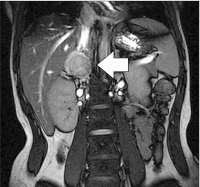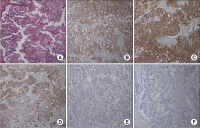An exclusively dopamine secreting paraganglioma in the retroperitoneum: a first clinical case in Korea
- PMID: 22708103
- PMCID: PMC3373991
- DOI: 10.4174/jkss.2012.82.6.389
An exclusively dopamine secreting paraganglioma in the retroperitoneum: a first clinical case in Korea
Abstract
Exclusively dopamine producing retroperitoneal paragangliomas are extremely rare. We have experienced the first Korean case managed successfully based on the proper evaluation. A 26-year-old female patient came to our attention after the accidental detection of an adrenal mass. She had no symptoms and denied any family history. Laboratory evaluations were normal but serum dopamine (425 ng/L) and 24-hour urine dopamine levels (1,565.3 µg/day) were elevated. She underwent laparoscopic right adrenalectomy. Histopathological diagnosis was a paraganglioma. After operation, dopamine levels in serum and 24-hour urine dropped to 0.09 ng/L and 388.4 µg/day. Dopamine producing paraganglioma elicit no clinical symptoms. Only the dopamine level is elevated in serum and 24-hour urine samples. Surgical resection without using preoperative alpha blockage is the treatment of choice. The prognosis for patients with this tumor tends to be poor because the diagnosis is usually delayed due to lack of symptoms.
Keywords: Adrenal glands; Adrenergic alpha-antagonists; Dopamine; Paraganglioma; Pheochromocytoma.
Conflict of interest statement
No potential conflict of interest relevant to this article was reported.
Figures




Similar articles
-
Microsurgical resection of a giant exclusively dopamine- secreting jugular foramen paraganglioma: A case report.Surg Neurol Int. 2025 Apr 25;16:147. doi: 10.25259/SNI_188_2024. eCollection 2025. Surg Neurol Int. 2025. PMID: 40353147 Free PMC article.
-
Dopamine-Secreting Pheochromocytoma and Paraganglioma.J Endocr Soc. 2021 Oct 29;5(12):bvab163. doi: 10.1210/jendso/bvab163. eCollection 2021 Dec 1. J Endocr Soc. 2021. PMID: 34870059 Free PMC article. Review.
-
Dopamine-Secreting Paraganglioma in the Retroperitoneum.Endocr Pathol. 2017 Mar;28(1):36-40. doi: 10.1007/s12022-016-9457-0. Endocr Pathol. 2017. PMID: 27743246
-
Dopamine secreting adrenal tumor-ganglioneuroma rather than pheochromocytoma: case report.Gland Surg. 2020 Dec;9(6):2204-2210. doi: 10.21037/gs-20-475. Gland Surg. 2020. PMID: 33447572 Free PMC article.
-
Dopamine-secreting phaeochromocytomas and paragangliomas: clinical features and management.Singapore Med J. 2010 May;51(5):e89-93. Singapore Med J. 2010. PMID: 20593136 Review.
Cited by
-
Microsurgical resection of a giant exclusively dopamine- secreting jugular foramen paraganglioma: A case report.Surg Neurol Int. 2025 Apr 25;16:147. doi: 10.25259/SNI_188_2024. eCollection 2025. Surg Neurol Int. 2025. PMID: 40353147 Free PMC article.
-
Dopamine-Secreting Pheochromocytoma and Paraganglioma.J Endocr Soc. 2021 Oct 29;5(12):bvab163. doi: 10.1210/jendso/bvab163. eCollection 2021 Dec 1. J Endocr Soc. 2021. PMID: 34870059 Free PMC article. Review.
-
Jugular Foramen Paragangliomas.Adv Tech Stand Neurosurg. 2024;49:201-229. doi: 10.1007/978-3-031-42398-7_10. Adv Tech Stand Neurosurg. 2024. PMID: 38700686
-
Dopamine-Secreting Paraganglioma in the Retroperitoneum.Endocr Pathol. 2017 Mar;28(1):36-40. doi: 10.1007/s12022-016-9457-0. Endocr Pathol. 2017. PMID: 27743246
References
-
- Feldman JM, Blalock JA, Zern RT, Shelburne JD, Gaede JT, Farrell RE, et al. Deficiency of dopamine-beta-hydroxylase. A new mechanism for normotensive pheochromocytomas. Am J Clin Pathol. 1979;72:175–185. - PubMed
-
- Proye C, Fossati P, Fontaine P, Lefebvre J, Decoulx M, Wemeau JL, et al. Dopamine-secreting pheochromocytoma: an unrecognized entity? Classification of pheochromocytomas according to their type of secretion. Surgery. 1986;100:1154–1162. - PubMed
-
- Eisenhofer G, Goldstein DS, Sullivan P, Csako G, Brouwers FM, Lai EW, et al. Biochemical and clinical manifestations of dopamine-producing paragangliomas: utility of plasma methoxytyramine. J Clin Endocrinol Metab. 2005;90:2068–2075. - PubMed
-
- Dubois LA, Gray DK. Dopamine-secreting pheochromocytomas: in search of a syndrome. World J Surg. 2005;29:909–913. - PubMed
-
- Tam V, Ng KF, Fung LM, Wong YY, Chan MH, Lam CW, et al. The importance of the interpretation of urine catecholamines is essential for the diagnosis and management of patient with dopamine-secreting paraganglioma. Ann Clin Biochem. 2005;42(Pt 1):73–77. - PubMed
Publication types
LinkOut - more resources
Full Text Sources
Research Materials
Miscellaneous

